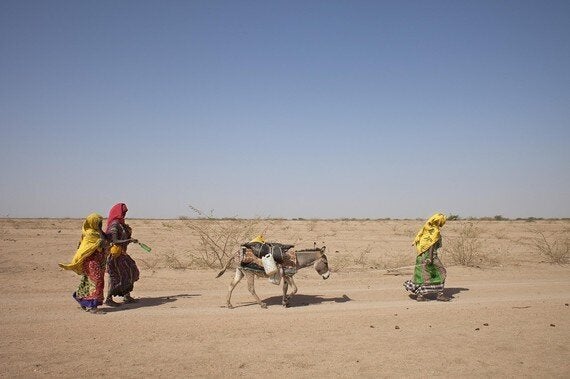
Most of us remember the image of thousands of Ethiopians starving during the famine of 1984/85, the luckier ones seemingly fed only by the power of the Western media to incite compassion and belated action from international agencies.
On a recent visit to the country, I heard how the weather conditions now are as bad as during that terrible disaster. In some ways they are even worse as the impact of climate change means that rainfall has been reducing over time, making droughts more common and giving people less time to recover before the next crisis hits. This time, El Niño is aggravating the long term challenges, intensifying the drought. Three successive rains have failed.
Driving out from the bustling town of Dire Dawa, east of the capital Addis, where the markets were full of people buying and selling vegetables and animals, I saw the vegetation get sparser by the mile. In such an arid region it wasn't that that raised alarm, it was the groups of people standing by pits beside the road, waiting for the tanker to bring them that most vital and scarce resource, water.
Just an hour or so from the town, a village leader described the terrible condition of the pastoralists as they had arrived with their few remaining animals over the preceding months. He told me of herders roaming for weeks between countries in search of food and water, steadily losing their animals to the drought until they arrived at the village where water and the bare minimum of food were available.
People are suffering. Pastoralists who roam distances across the Sahel and between countries are finding no water or grazing. They have watched their animals die or sold them at knock down prices. Hundreds of thousands of people have lost their crops and all their assets.
Ten million people - more than the combined populations of Greater London and Birmingham - are now in need of help to feed themselves. People told me just how often the rains now failed. They didn't have time to recover from one drought before the next one hit. To us it is climate change, to them it is their livelihoods wiped out.
Yet despite such hardship, the truth is that Ethiopia has come a long way over thirty years. It is less poor, better prepared and its government is insistent that it can and will lead the response. Although 85% of its 100 million people remain dependent on rain fed agriculture, there is more irrigation and more boreholes to supply water in remote areas.
Unlike 30 years ago, this time around most people hit by the drought are getting at least some help. The Ethiopian government is leading a complex operation that is now getting food and water to many millions. Village heads and health workers tell the same story as local officials, that people are struggling but aid is getting through.
Malnutrition is a serious challenge even in normal times but health workers describe how people's health has improved in recent months as the operation has been scaled up. There is severe drought, and there is not enough assistance, but there is not yet a famine. That is a major achievement.
Oxfam is playing our part. Working closely with local organisations we are providing water to hundreds of thousands of those most affected, giving out money to buy essentials to those in greatest need, helping people feed enough animals to breed from when times improve, buying animals off people who can't feed them and using the meat to feed those most hungry and undernourished.
No one involved in the relief effort - the Ethiopian government, NGOs like Oxfam or international donors - can afford to be complacent. Resources and logistics are massively stretched. Delivering food and tankering water up to hundreds of kilometres is expensive and challenging. The combination of government resources and international aid is still not enough to sustain and extend the operation. Help is uneven and there remains a real risk the situation could deteriorate again.
Nor will the problems be over when the rains do come. It will take months for crops to grow, and people will need seed. They have had to eat what they have. Even if help if forthcoming, the rebuilding stocks of cattle and goats will take years.
Donors, including the British government, have helped but so far only half of the £1billion needed to meet the needs of people this year has been pledged. Officials I met from the Ethiopian government were adamant that they will mobilise whatever funds are needed, but if they don't get more outside support they are clear that will have to take money from other essential activities including education and health.
A recent Washington Post headline screamed that history is repeating itself in Ethiopia. The truth is that it isn't, not yet at least. Climate change, overwhelmingly caused by rich countries would have it so. But the fruits of development, preparation and a better managed response mean that a different outcome is possible.
Disaster has so far been averted but the struggle is not over yet. The rains are still to come, funds are to be raised and the humanitarian operation maintained and extended. The 1980s famine indelibly linked the image of starving children with Ethiopia for a generation. Thirty years on, Ethiopians have a chance to cast off that shadow but we all need to do more to make sure it happens.
Image copyright Oxfam
